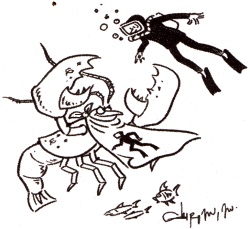Spearfishing - Choose Your Weapon

There are essentially two choices of weapon for spearfishing: pole spears and spearguns. The speargun is probably the first thing that comes to mind for most readers - conjuring up images of Seahunt, James Bond, and countless other TV shows and movies. Everyone knows what a speargun looks like - a roughly pistol-shaped device that fires a two-foot steel dart. Everyone probably also has a pretty good idea what a pole spear looks like, but an underwater pole spear is a different in form and use from a terrestrial javelin. Rather than throwing it ( which would be difficult to impossible underwater ) a pole spear ( or "Hawaiian sling" ) has a loop of rubber tubing at the butt end that is used to launch it directly from the hand, the shaft sliding through the loosened hand without ever leaving it.
Spearguns

Spearguns are useful for hunting large fishes, such as Blackfish, which require greater hitting power for a good penetration. However, complicated multi-step loading procedure, and consequent low rate of fire make spearguns far less effective on smaller quarries, such as Sea Bass and ling. Spearguns have a longer range than pole spears ( which is not always useful in poor visibility ) but there is always the possibility that you may lose your spear if a struck fish drags it out of reach into a hole and it wedges there. Just such a situation led to my first ever decompression dive ( but I got my spear back, and a 10 lb tog. ) Finally, with a speargun, if you miss, forget about it - by the time you reassemble the whole thing, the fish will be gone.
Compact, short-range "rock-style" guns are more useful than the long blue-water guns that are used in the tropics. The best point for a speargun is the twin-barbed point. Don't worry about keeping it razor-sharp - your misses will dull it up pretty quickly. You can return it to some degree of pointiness with a hand file from time to time. Spearguns have higher maintenance costs than pole spears, as the bands wear out surprisingly fast, and are not cheap. Carry extras - you can even wrap one around the buttstock of the gun for underwater replacement. The "high-power" amber bands ( JBL 216 ) wear out particularly fast - replace them with the thinner black ones ( JBL 614 or 618. ) When replacing speargun slings, remember that the quoted length does not include the metal band, only the rubber tubing.
Pneumatic ( air-powered ) guns are also available. I don't like them, and I don't even like being around them, although in truth I have never seen an accident. JBL makes good aluminum or wood band-style guns, although over time the trigger mechanisms tend to bind up. AB Biller guns are more expensive but have much smoother longer-lasting releases. Another big name in spearguns is Riffe, which makes beautiful but terribly expensive spearguns.
Pole Spears


A pole spear has much less hitting power than even a small speargun, but a much faster reload time. This makes them good for Sea Bass and many smaller fishes, and even medium-sized Blackfishes. Some fish are even dumb enough to hang around after a miss and give you a second and sometimes a third shot with a fast-loading pole spear.
Pole spears are also less prone to entanglement than spearguns - making them useful for shooting into holes and crevices. Low initial cost and low maintenance ( just a new piece of surgical tubing now and then ) make this a very cost-effective weapon. Although most spears come with a cheap single-pronged point, a three-pronged barbed "paralyzer" tip is far more effective and well worth the extra cost.
Over time, the tines on a paralyzer will spread out, and also become dulled. I have found that sharpness is not critical, and a quick cleanup with a file several times a season is all that is necessary for the points. However, the spreading of the tines greatly reduces the effectiveness of the tool, both in accuracy and penetration. The points on the tines should form a triangle 1/2 inch on a side. The best way to straighten them is to place the spear on a hard surface ( like a garage floor or sidewalk ) and pound the tines down with a hammer at their bases.
Most of the local shops seem to stock only near-useless unbarbed paralyzers. Order a good one from Leisure Pro if you can't get one locally. JBL part # 846, not 845. If you want to build your own spear, most points are threaded for a 6mm bolt.
Recommendation
My preferred spearfishing rig is a long hollow aluminum pole spear with a barbed paralyzer tip, which makes the whole thing almost 7 ft long ( it breaks down for transport. ) the spear floods with water in use, which gives it greater inertia and hitting power, easily enough to take down even a large Blackfish with the right technique. The only thing this rig gives up to a speargun is range - its useful range is about half that of a speargun.
The two advantages of the pole spear over the speargun are control and rate-of-fire. When a speargun is fired, the spear flies away on its tether, and until you can swim to it and actually place your hands on your prey, you have very little control over the situation. In these few critical seconds, many a fish with thrash itself free and escape. Since a pole spear never actually leaves your hand, you never lose control. This will become apparent in the techniques described below.


